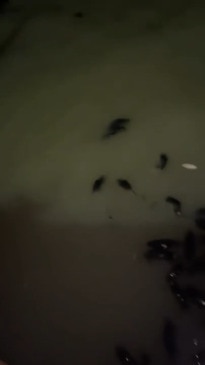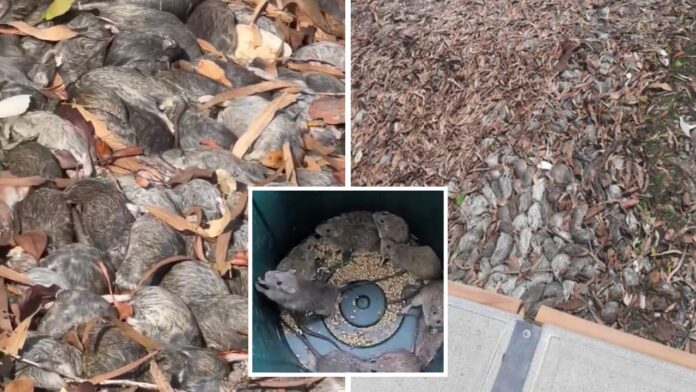[ad_1]
Residents are horrified by a plague of rats that has descended on a usually picturesque Queensland fishing town, leaving a foul smell as they die and decay on the beaches.
Locals in Karumba, in The Gulf Country between the Top End and the Northern Territory, say the rats appeared a few weeks ago and have since surged in numbers.
Images and videos posted to social media show what appear to be thousands of rats, often dead or dying and piled up on beaches, at the edge of boat ramps and on footpaths by the water.
Another disturbing clip, this one taken at night, shows hundreds of rats floating in the water, surging in and out with the tide.

“They’re really getting out of control,” one Karumba-based commercial fisherman told ABC North Queensland.
“There’s a stench along the riverbed. Last night, with the moonlight, the river was truly alive with them.”
Another resident commented: “We saw them dead or alive (but exhausted) in the water and on the shoreline. (When we returned four days later), they were running on the sand”.
A third resident said there were “millions and millions of rats on the road” outside Cloncurry, about 350km south of Karumba.
“Every dead rat on the road had another three or four rats eating it. There was about a metre between dead rats. It was insane,” he said.
“You drive between McKinlay and Winton at night and the ground is crawling with rats. They are that thick, they’re eating their own straight after they’re squished on the road,” another posted.
It’s believed the rats, which are a native species, are swimming out to nearby sand islands in search of more food but, once they get there, they don’t have the energy to swim back and die before washing back up on shore.
Queensland has been battling what’s been described as a rat and mouse plague for several months, with the wet season and an abundant harvest creating ideal breeding conditions.
It’s this population boom that has forced the rats into the water, as the mainland simply doesn’t have enough food to support them all.
“Most rodents eat vegetation, seeds, they’ll eat insects and they’ll eat everything at plague proportions,” University of Sydney ecology professor Mathew Crowther told Yahoo.
“Our animals are adapted because they have these really variable rainfall patterns and animals concurrent with that are quite successful, they can respond quickly.”
While residents can fight to keep the rats out of their homes, there isn’t much that can be done to curb their numbers other than letting nature run its course, Associate Professor Crowther said.
“They tend to get really high numbers but then they start crashing because they’ve eaten their food sources out,” he explained.
[ad_2]
Source link


